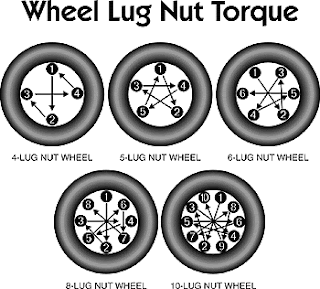Some vehicles are equipped with full size spares. What that means is that the spare is the exact same size (height and width) as the other four on the vehicle. Others are equipped with a spare in which are significantly smaller than what's on the vehicle. Keep in mind that these types of spares are ONLY to be used to get from where you are to your final destination. Most are not recommended to be driven more than 100 miles and are not to be considered a replacement or to carry you through a long trip.
If there's one thing I remember from my childhood, it's the Boy Scout Motto: "Be Prepared". Make sure you have the proper tools to change your tire.
[ ] Spare tire. Surprisingly more cars these days are not coming with a spare tire but with a tire inflator. If you fall in this bracket, visit your local tire shop where you could purchase a wheel and tire combo as your spare. They can make sure you have a wheel with the proper offset and bolt pattern that fits your vehicle. (I'll define these in another article.) Chances are that a full size spare will not fit in your vehicle without taking additional trunk space. If you're not comfortable with that, find a tire option that will fit and still serve its purpose. A tire inflator will not help if your flat is due to a puncture in the tire.
[ ] Jack and Lug nut wrench. Most cars do come equipped with this. However, if you've bought your vehicle used, these items are sometimes missing. You can purchase any of these at your local auto parts store. If this is included in your car, check your owner's manual for where the car manufacturer put it. Possible locations for a car include under the mat in the trunk, in a side pocket of the trunk. Possible locations for a truck include under or behind the rear seats.
[ ] Owner's manual. If you bought your vehicle used, you might find this missing also. No worries. The car manufacturer's dealership can sell you a replacement. Or, these can usually be bought on eBay or various places for a pretty cheap price.
[ ] Flashlight. You never know when a good flashlight will come in handy. Be sure to check the batteries regularly!
[ ] Gloves. If you're someone who is normally dressed for an office environment, you may not be properly dressed for a nasty tire change. Gloves won't keep your clothes clean, but they'll help you from transferring any dirt from your hands to your clothes when you get back behind the wheel.
Now that you have all the proper equipment, let's give it a shot. Go ahead and practice at least once. They say practice makes perfect. So what do you do?
1) Pull off to the right shoulder of the road. Turn on your hazards. Safety first! This lets the other drivers know there's a car on the side of the road. If the flat tire is on the driver's side, move as far right as possible.
2) Get out your spare tire and tools. Do this from the passenger side (away from moving traffic) if you can. Get those gloves on.
3) Use your lug nut wrench and break the lug nuts loose. Here's where my other blog: Beware of the impact wrench can be helpful.
By using the tire's friction against the ground, it'll help you to break loose the lug nuts. The lug nuts should be on pretty tight. What a sight it would be to see your wheel to pass by while you're driving! However, they should not have been tightened so much that you cannot undo the lug nuts even by jumping on the wrench.
 |
| Car Jacking Points |
If you have a truck, you will be jacking up near the suspension of the vehicle. Sometimes it's a plate just under the shock.
5) Remove the lug nuts the remainder of the way off the wheel studs. Remove the wheel with the flat tire. Now, keep in mind, your tire is flat, and you have just jacked the car high enough to remove it. Here you'll have to test fit the spare tire and jack the car up as necessary to place the spare on.
6) Once your spare is on, start threading the lug nuts back on the car. When you do this spin your tire (if it'll spin). This will help you center the spare. If not, wiggle the spare as you tighten down the lug nuts. At this point the lug nuts should on be "hand tight". No tools are to be used.
 |
| Wheel tightening pattern. |
8) Check to make sure nothing is left under the car and slowly let the jack down.
9) Yay! Your car is back on the ground. While on the ground, re-tighten the lug nuts with your lug nut wrench just to make sure they're on nice and tight.
10) Pack it up!
If you do not have a full size spare, drive slowly. You don't want to drive too terribly fast and some of the spare tires will have the max speed written on the side of the tire. This is for your safety so please follow these.
A flat tire situation is never exciting. However, being prepared for it can make it less painless. Be safe!
Bryan Lin | CEO, The Motorsports Authority, Inc. | MSAStore.com




